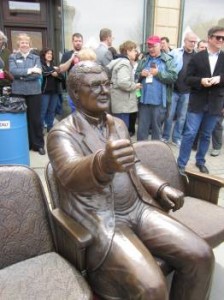 The highlight of the first full day of Ebertfest was the unveiling of a new statue of Roger, at the movies, thumb up. The statue will be installed in front of Roger’s beloved Virginia Theater situated so that visitors can take photos that include its iconic marquee. And the sculpture is expressly designed for selfies — visitors can sit on either side of Roger to snap themselves.
The highlight of the first full day of Ebertfest was the unveiling of a new statue of Roger, at the movies, thumb up. The statue will be installed in front of Roger’s beloved Virginia Theater situated so that visitors can take photos that include its iconic marquee. And the sculpture is expressly designed for selfies — visitors can sit on either side of Roger to snap themselves.
Then we all went inside the Virginia Theater, where I was delighted to see two of my favorite films of 2013, “Museum Hours” and “Short Term 12.” Jem Cohen spoke about the interplay of documentary and narrative and improvisation that made “Museum Hours” so captivating. “Maybe it’s all A-roll,” he said, meaning that the usual line between what we think of as the main storyline and the background footage used to set the scene may be not as much of a line as we assume. When asked why he filmed a key scene at a distance from the characters, he said, “The film school I didn’t go to would probably have said that was the place for a close-up.” But it was clear that both he and the audience felt the extra space he gave the characters was respectful and touching.
I was honored to be asked to interview two of the stars of “Short Term 12” on stage following the screening. Brie Larson, who also appeared with me on a panel earlier on “Challenging Stigma Through the Arts,” and Keith Stanfield talked to me and then answered questions from the audience. Stanfield, who appeared in writer/director Destin Cretton’s short film inspired by his experiences working with troubled teens, said that he then auditioned for the expanded feature film and Cretton wept as he tried out for the part. He also told us that he had to reject Cretton’s initial attempts at rap lyrics for his character. Larson, who shadowed a caretaker in a facility for at risk teenagers to prepare for her role, told us that “accepting that pain, using that weakness as a strength, then it becomes love, it becomes safety, it becomes a community and a way to progress.”

